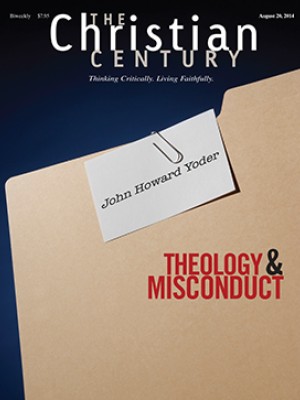Special liturgy atones for outbreak of Great War
Half a world away from Europe, where World War I erupted 100 years ago on July 28, Washington National Cathedral marked the occasion with a liturgy created especially for the anniversary.
But the service was about more than remembrance. It was about atonement—atonement for the 16 million killed in the conflict and the more than 20 million wounded, many of them horribly disfigured in trench warfare that kept much of the four-year conflict at a stalemate.
“I was struggling with praying for the beginning of a war,” said Gina Campbell, the Washington, D.C., cathedral’s canon precentor and the author of the World War I liturgy. “I was trying to put my mind around how one prays for the beginning of a war. I thought it would need to be profoundly penitential, that the way one would approach the disaster that is World War I would have to be in deep penitence.”
Read our latest issue or browse back issues.
Campbell crafted the liturgy at the request of Congress’s World War I Centennial Commission, which is organizing memorial events around the country for the next four years. She was part of a committee that included Episcopal bishop Jay Magness (who oversees military chaplains), retired navy chaplain Wollum Jensen, the cathedral’s music director, and others. They and the cathedral have made the liturgy available online for other houses of worship to use or adapt.
“One hundred years ago, an assassin’s bullet plunges the nations of the world into violence unlike any the world has ever seen,” the service’s litany of prayer begins, before citing the number of dead and wounded, including civilians.
“From the fields of Flanders to the forests of Verdun to the peninsula of Gallipoli, the dead cry out: life and love interrupted; hope and promise laid waste; war, war, and more war. Forgive us!”
Campbell worked to craft an interfaith service, relying heavily on the Hebrew Bible for readings and leaving out the name of Jesus in most of the prayers.
“I wanted to reach as many kinds of worshiping communities as possible because in World War I there were huge numbers of Muslims fighting, huge numbers of Jews,” she said. “This was not a Christian war, and the prayers should reflect that.”
She also tried to make sure the service did more than mark a great conflict.
“I thought, this can’t just be a commemoration, this has to speak to a contemporary situation as well,” she said. “Church is not just about remembering, it is about remembering forward. We have to bring it into the present and into God’s hope for our future.”
The Conference of European Churches and the Community of Protestant Churches in Europe have also created relevant resources. Bishop Stephen Platten of the Church of England has crafted a liturgy as well: “For all the boots of the tramping warriors / and all the garments rolled in blood / shall be burned as fuel for the fire,” the service’s Old Testament canticle begins. “For a child has been born for us, a son given to us, / and the government will be on his shoulders.” —RNS
This article was edited August 20, 2014.





